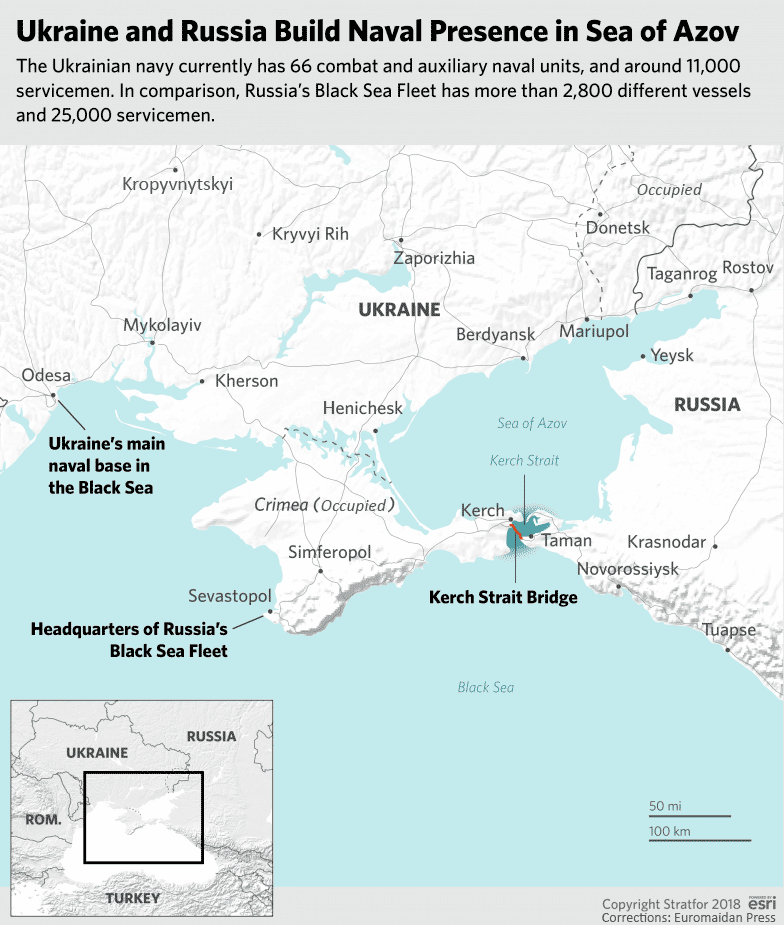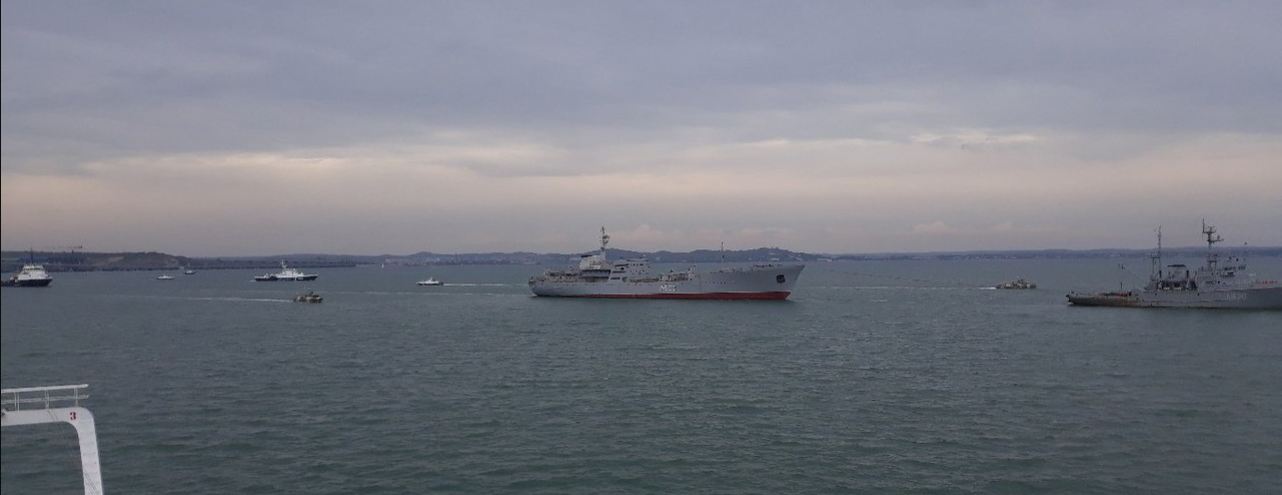The passage of the Ukrainian ships became a headache for Russia since it claims the adjacent waters in occupied Crimea are Russian, while the rest of the world considers them Ukrainian.
The two ships examined how far Russia will go. Russia chose to do nothing.
Pre-history: Is Russia preparing to attack Mariupol by blockading Ukrainian Azov Sea ports?
Passage
On 16 September, the Ukrainian government announced its plans to create a naval base in the Azov Sea before the end of the year. A few days later President Petro Poroshenko confirmed the intention in his address to Verkhovna Rada.
The Ukrainian Military Portal (UMP) media outlet reported on 23 September that the ships of the Ukrainian Navy, search and rescue vessel A500 "Donbas" and the tug A830 "Korets," left the Western Naval Base in the Black Sea port of Odesa for Berdiansk on 20 September to found a new Ukrainian naval base in the Sea of Azov. No official reports emerged then and the Portal cited its own sources.
According to the 2003 agreement, the Sea of Azov is an inland sea of two states, according to which civil and military vessels under the flags of Ukraine and Russia can pass through the strait and go to their ports. With the aggravation of the situation on the Azov Sea, the command of the Ukrainian Naval Force decided to take advantage of it in accordance with the needs that have arisen, explained UMP.

According to 22 September report
by the Russian state news agency TASS, two ships of the Ukrainian Navy had "crossed into Russia’s exclusive economic zone off Crimea" and were "being escorted by ships of the Russian FSB Border Service’s Coast Guard."
Two ships of the Russian border guard patrol started escorting the Ukrainian warships as they were passing by the occupied port of Sevastopol. As the Ukrainian "convoy" was approaching the Kerch Strait, the Russian escort grew to at least seven military sea craft, among them were:
- The tug SB-739 KChF;
- 2 patrol boats of the project 03160 "Raptor" carrying the special force of Russia's Black Sea Fleet;
- The project 10410 "Setlyachok" ship of FSB's coast guard;
- 2 "Mangust" boats of the project 12150;
- A boat of the project 21850 "Chibis" of FSB's coast guard.
As of 23 September, 10:25 EEST, the warships approached the area of the Kerch Strait.
Later the reports emerged that the Ukrainian small armored artillery boats P177 Kremenchuk and P178 Lubny, earlier brought by land to Berdiansk, departed from the port in the direction of the Kerch crossing, to meet "Donbas" and "Korets".
"A Ukrainian ‘squadron’ entered the channel at 13:50 Moscow time [MSK, the same time as EEST - Kyiv summer time - ed.] and passed under the bridge at 15:15 Moscow time," Russian state news agency TASS cited Alexei Volkov, Director General of the "Crimean Sea Ports state company."
A video shared by the pro-Russian local news site KerchInfo shows the passage of "Donbas" and "Korets" under the bridge followed by two Russian armored boats and two more escort ships:
Ukrainian President Petro Poroshenko welcomed the passage of Ukrainian warships to the Sea of Azov and noted that the vessels will be part of a new naval base of the Ukrainian fleet in the area.
The late official Russian reaction was, "Ukrainian naval ships Donbas and Karets passed through the Kerch Strait, which links the Black Sea and the Sea of Azov, with due permission from Russian control agencies that is required under law," as TASS cited the press service of Russia’s Federal Agency for Maritime and River Transport [Rosmorrechflot] on 24 September.
According to UMP's update
of 24 September at 20:10, the search and rescue ship "Donbas" and sea tug "Korets" have arrived in Mariupol escorted by Ukrainian armored artillery boats "Kremenchuk" and "Lubny."

Has Russia land-locked Ukrainian Azov ports?
Starting from May 2018, Russia imposed a "hybrid blockade" of the Ukrainian Azov northern-coast seaports of Berdiansk and Mariupol. The Russian secret police FSB's border guard service has been carrying on illegal inspections of all commercial vessels sailing to and from the Ukrainian ports.
In June, Ukrainian Navy chief Ihor Voronchenko called the Russian actions in the Black and Azov seas, “Further ‘creeping’ annexation of our exclusive maritime economic zone.”
In August secretary of Ukraine's National Security and Defense Committee Oleksandr Turchynov warned that Russia planned "further expansion" and sought to impose "military and economic blockade of Ukraine's Azov coast."
One of the clear Russian objectives is to undermine the economy of Berdiansk and Mariupol. Shippers, delayed by the inspection, are losing between $5,000-15,000 per hour as a result of the Russian checks. The Russian strategy is to make imports and exports from both ports economically unprofitable.
As Russia failed to grab a land corridor to Crimea by military force back in late 2014, it decided to join the occupied peninsula with mainland Russia via a bridge in the Kerch Strait. However, the Crimean agriculture
and industry suffer without Ukrainian water supplies fro the Dnipro River, cut off shortly after the beginning of the occupation. So the issue of a land corridor to Crimea still persists for Russia.
The Kremlin is trying to destabilize Ukrainian Azov coastal territories via military and informational provocations, believes Ihor Kabanenko, retired Ukrainian Navy admiral. The commercial losses caused by Russia to the international cargo ships is one of the tools used to undermine the economy of the Ukrainian Azov coastal region.
What could Russia do?
Russia could try to detain the Ukrainian ships or even arrest them since they were passing through what Russia believes to be its territorial waters. This could result in new international sanctions against Russia, because only Russia considers Crimea and its territorial waters Russian, for the rest of the world Crimea remains Ukrainian.
Russia could try to attack the ships in the Azov Sea with the so-called "DNR Naval Force" - a few fishing boats remade to carry firearms. In this case, Ukrainian armored artillery boats would drown the "DNR" craft and there would be no significant consequences even for the Minsk peace process since the accords are about the peace settlement in the land and there's nothing about sea warfare.
The last option was to let the Ukrainian ships pass, and Russia has chosen to do so. Such a decision was detrimental only to the Kremlin's domestic public image - Ukrainian ships coming without any problem through "Russian territorial waters" demonstrates that "Great Russia" isn't as strong as the propaganda image purports it to be.
Ukrainian naval expert Taras Chmut believes the Russian navy most likely didn’t expect Ukraine’s ships to risk passing through the Kerch Strait. “We seized the initiative,” Chmut said. “For the first time, we didn’t just react to the Russians’ steps, but started to set our own game rules.”
Read also:
- What caused the environmental disaster in occupied Crimea? A chemist explains
- Crimea’s growing water problem might provoke new Russian attack against Ukraine
- Occupied Crimea is running out of water
- Moscow boosting tensions in Sea of Azov but can't change strategic situation there
- Moscow seeking to provoke revolts in Ukraine's Azov Sea ports
- Ukraine has law but not force on its side in Sea of Azov
- How Putin's Crimean bridge grew over 2016-2017 - satellite images
- Scandal as Dutch companies help build bridge to occupied Crimea
- How much will Crimea cost Russians?
- Russia positioning to attack Ukraine from Sea of Azov

